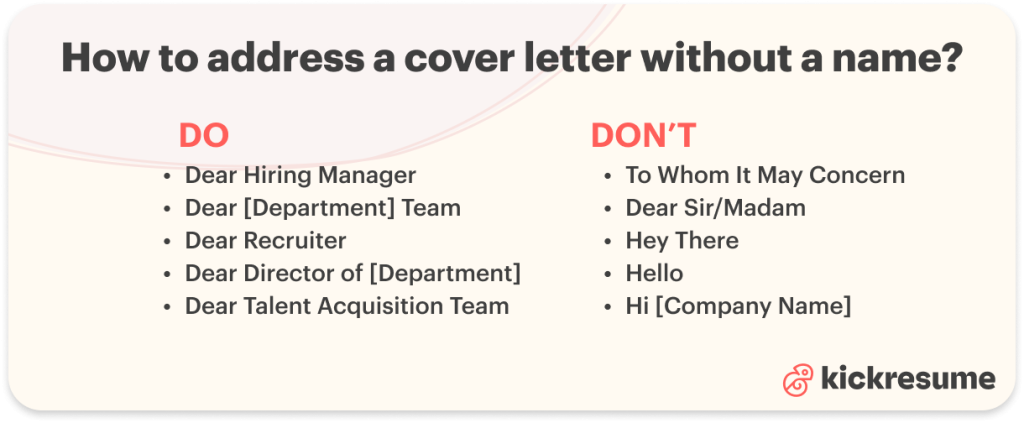Struggling with how to address a cover letter without a name? It's a common challenge that can make even the most confident job seekers pause.
Ideally, you want to personalize your cover letter salutation to show you've done your homework.
But what do you do when that information isn't readily available?
If this sounds familiar, you’re in the right place. Whether the job ad skipped the contact details or your online searches came up empty, we've got your back.
This article will show you:
- 5 different ways how to address a cover letter without a name
- How NOT to address a cover letter without a name
- Strategies to find the hiring manager's name
- Cover letter examples
- How to find the hiring manager's name?
- How to address a cover letter without a name? Use these 5 salutations
- How NOT to address a cover letter without a name
- Tips for addressing a cover letter with no name
- Where to place the cover letter address
- Key takeaways: How to address a cover letter without a name?
How to find the hiring manager's name?
It's not a deal-breaker to address your cover letter without a specific name.
However, addressing it to a specific person and including a name can add a personal touch that sets your application apart.
If you've hit a wall in your search for a name, don't give up just yet.
Try these five strategies to uncover the name of the hiring manager:
- Check the job posting again. Sometimes the answer is hidden in plain sight. The bottom of the job listing might include instructions like "Email your resume to janedoe@company.com," which not only gives you the hiring manager's email but also their name.
- Use LinkedIn. Search the company's page and browse through employee profiles. Look for individuals with titles that might indicate they're in charge of hiring, such as "Talent Acquisition Manager" or heads of the department you're applying to.
- Search the company website. Most organizations have an 'About Us' or 'Team' page where they list their staff members and their roles. Here, you can often find clues about who might be the hiring manager or at least get the names of potential contacts in the right department.
- Try networking. Reach out to your existing network to see if anyone has connections within the company. Sometimes, a mutual contact can provide you with the name you need.
- Call the company. It might seem a bit old-fashioned, but it's a direct approach that can yield results. A polite phone call inquiring about who is managing the hiring for the position you're interested in can sometimes get you the information you need.

How to address a cover letter without a name? Use these 5 salutations
Starting your cover letter with the hiring manager's name is the best way to go. It shows you've looked into the company and are serious about the job.
But, if you've tried and still can't find a name, don't worry.
Here are some ways to address your cover letter when you don't know who will read it:
- Dear Hiring Manager. This straightforward approach is professional and widely accepted. It shows respect for the person reviewing your application.
- Dear [Department] Team. Mentioning the department, like "Dear Marketing Team," shows you know where you want to be and who you're talking to.
- Dear Recruiter. Use this if you're applying through a recruiter or if the job ad was posted by HR. It shows you understand the process.
- Dear Director of [Department]. If you know the department but not the name, this shows you've thought about where you fit in the company.
- Dear Talent Acquisition Team. Perfect for when your application will be reviewed by several people. It shows you understand the process.
These ways help you start your cover letter professionally, even when you can’t find a specific name. They show respect and that you're thoughtful about your application.

How NOT to address a cover letter without a name
When crafting your cover letter, it's just as important to know how NOT to address it.
Steering clear of certain greetings can help maintain the professional tone of your application.
Here are some salutations to avoid:
- To Whom It May Concern. This is overly impersonal and outdated.
- Dear Sir/Madam.This comes across as old-fashioned and can be seen as gender presumptive.
- Hey There. Far too casual for a professional document.
- Hello. While friendly, it lacks the formality a cover letter requires.
- Hi [Company Name]. This is too informal and doesn't address any individual or specific role.
Tips for addressing a cover letter with no name
Crafting a cover letter without a specific recipient's name doesn't mean you can skimp on professionalism.
Here's how to ensure your cover letter makes a great impression, even when you're not sure who will read it:
- Stick to formal greetings. Use "Dear Hiring Manager" to start off on the right foot. It’s respectful and works every time. Yes, even if the company culture is really laid back.
- Avoid addressing recruiters. Directly addressing recruiters is generally not advised, unless you have been in contact with one specifically for this role. In such cases, using their name can add a personal touch.
- Target the right department/person. Make every effort to verify you're targeting the right person or department within the company. Otherwise, it can redirect your application to the wrong hands.
- Spell-check the name. Found a name? Double-check the spelling. Getting it wrong can look bad.
- Focus on the cover letter content. The most important part is what you write in your letter. Make sure it's tailored to the job you want and shows off your skills. Here are a few additional resources:
Where to place the cover letter address
When setting up your cover letter, start with your name centered at the top. It looks neat and professional. Right below your name, put the company’s address on the left side and your address on the right. This way, both addresses are easy to spot.
Next, add the date below your address. It shows when you sent the letter.
Right under the date, write your greeting, like “Dear Hiring Manager.” This is where your actual letter begins.
We’ve got a sample below to show you how it should look. It’s made with Kickresume's cover letter builder. This tool is great because it gives you a template that’s easy to fill out. It makes sure your cover letter looks good without much effort.
Key takeaways: How to address a cover letter without a name?
In wrapping up, let’s quickly recap the 5 best salutations to use for addressing your cover letter when the name is unknown:
- Dear Hiring Manager
- Dear [Department] Team
- Dear Recruiter
- Dear Director of [Department]
- Dear Talent Acquisition Team
But remember, the strength of your cover letter lies in its content.
A well-crafted letter that speaks directly to the job description and showcases your skills can make a significant difference. Personalizing your cover letter as much as possible helps you stand out from the crowd.
For those struggling with writer's block, Kickresume's AI resume builder is an invaluable tool. It can help you write the first draft of your cover letter based on your job title and job description, making personalization easier and more effective.




